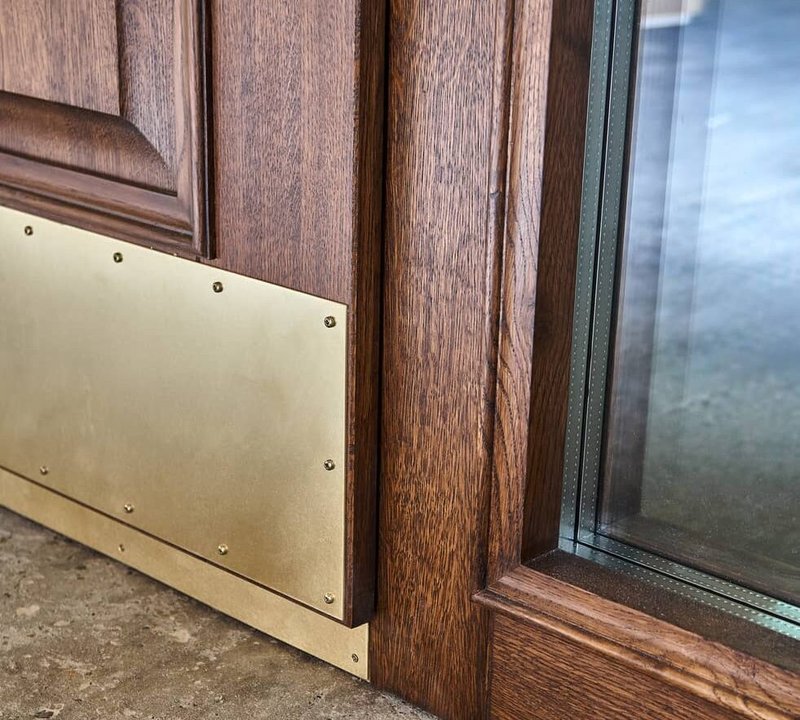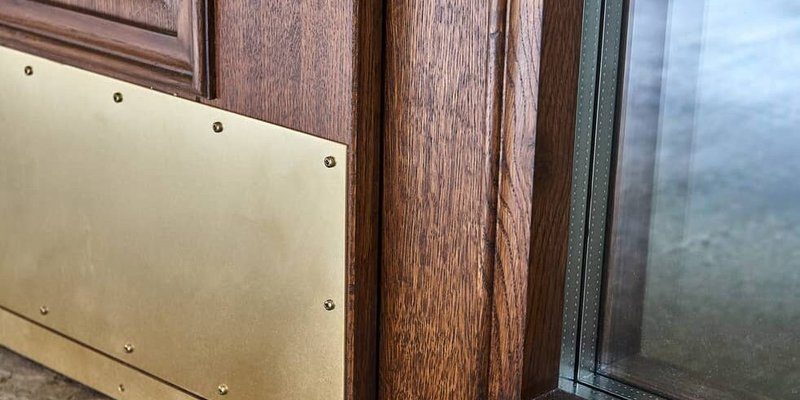
Matching hardware isn’t just about looks—it’s about making the whole room feel pulled-together. When one piece clashes, it’s distracting. And if you’ve recently installed something like a Baldwin or Kwikset kick plate (two super common brands), only to realize it sticks out like a sore thumb, you’re definitely not alone. Let’s dig into why this happens, what you can do about it, and how to troubleshoot your way to a more polished look—without stressing out or throwing money away.
Why Kick Plates Sometimes Don’t Match Other Hardware
You might be wondering why a kick plate, of all things, would end up looking so different from your other door hardware. Here’s the thing: even if you buy everything from the same hardware store, finishes can vary a lot. Brands like Baldwin or Kwikset might call something “satin nickel,” but their version of that color can be slightly warmer, shinier, or more matte than the hinges or handles nearby. Metal finishes aren’t as universal as their names sound.
Another issue is lighting. That kick plate sits front and center, often catching more light, and suddenly the color difference is even more obvious. Plus, *kick plates* are made from different types of metal or coatings than your handles, which can change how they “take” the finish. Even the age of your hardware matters: new pieces look fresher and brighter, making any mismatch really pop.
Honestly, when you’re at the store or shopping online, it’s easy to focus on shape and size—only to get home and realize the tone is way off. It’s a common problem and not a sign you did anything wrong.
How to Diagnose the Finish Mismatch
First, take a good look at your kick plate and the hardware you’re trying to match. Set them side-by-side in the same light. Sometimes, a finish mismatch is subtle—maybe the kick plate is just a bit redder or more yellow, but sometimes it’s glaringly obvious, like mixing chrome with gold.
Here are some things to check:
- Is the kick plate more glossy or matte than your handles?
- Are the metals actually different types? (Brass vs. nickel vs. chrome)
- Does the brand or model number match?
- Does the kick plate look aged or tarnished?
If you’re not sure, look for identifying codes or markings on the hardware. Sometimes there’s a tiny label or number you can look up online to see exactly what finish you’ve got. Baldwin and Kwikset, for example, both use specific finish codes (like 003 for polished brass or 514 for iron black). Matching codes usually means matching color—*unless* the metal base is different.
What to Do When Your Kick Plate Doesn’t Match
So, what can you actually do if your kick plate stands out in all the wrong ways? You’ve got a few solid options, ranging from quick fixes to more involved changes.
Option 1: Replace the Kick Plate
The simplest route is to return the mismatched kick plate and find one that matches your handles and hinges exactly. Look for the same finish code and brand if possible. Yes, this might take some hunting, but it’ll save you headaches later. If you can, bring a sample handle or knob with you to compare in person.
Option 2: Change All the Hardware
Maybe your kick plate looks great, but the door handles are the odd ones out. In that case, sometimes it makes sense to swap out all the hardware for a unified look. This route costs a bit more, but it’s a chance to upgrade to all new finishes. This is especially worth it if your current hardware is old or worn out.
Option 3: Paint or Refinish the Kick Plate
If returning isn’t an option, consider painting or refinishing the kick plate. Believe it or not, you can use metal spray paints or special polishes to get a closer match. Just be sure to clean it thoroughly, use a primer if needed, and pick a product made for metal. This works best for parts that won’t get scratched a lot—or if you’re okay with the look aging over time.
Can You Refinish a Kick Plate Yourself?
Let me explain—it’s absolutely possible to refinish a kick plate at home, but there are a few things to consider. Some finishes, especially those that are lacquered or coated, don’t take new paint or polish well. You might have to strip the existing finish first, which means using chemical strippers or sanding. If the kick plate is solid brass (like many Baldwin models), you’re in luck: brass takes polish and new finishes beautifully. Just be ready for a little elbow grease.
If it’s a coated or painted aluminum kick plate (more common with brands like Kwikset), you’ll need to use a primer designed for metal before painting. Make sure you’re working in a well-ventilated area and lay the kick plate flat to avoid drips.
Steps for DIY refinishing:
- Remove the kick plate from the door.
- Clean thoroughly with a degreaser or soapy water.
- Sand lightly to help paint stick.
- If painting, use a spray primer, then several thin coats of metal paint.
- Let dry completely before reattaching.
*Pro tip: Test your paint or finish on a scrap of metal or the back of the kick plate first. Finishes can look wildly different once dry.*
Are Universal Kick Plates a Good Solution?
Universal kick plates promise an easy fix: “One size fits all, matches any hardware.” Here’s the thing—while the sizing might work, the finish and style might not. Universal options often use generic finishes like plain stainless steel, which may end up looking colder or shinier than your other hardware.
That said, some universal kick plates come in common colors (like oil-rubbed bronze or satin nickel) and might be close enough to work. If your hardware is a pretty standard finish, and you’re not fussed over a tiny mismatch, it might be a simple solve.
But if you’re looking for a *perfect* match—especially for high-end brands or distinctive finishes—you’ll probably do better sticking with brand-specific plates or going the custom route.
Common Mistakes When Trying to Match Door Hardware
It’s easy to slip up when matching kick plates to the rest of your hardware, especially if you’re in a hurry or ordering online. Here are a few pitfalls to watch out for:
- Assuming all “nickel” or “brass” is the same. Every company’s finish can look different, even if the name matches.
- Ignoring the base metal. Brass kick plates have a different warmth than nickel-plated steel. The underlying color can show through, especially after some wear.
- Ordering without samples. If possible, get a sample or see the hardware in person before buying a full set.
- Forgetting about lighting. Kick plates catch more direct light than knobs or handles, exaggerating differences.
Honestly, I’ve seen projects where people had to try three different brands before finding the right tone. Don’t feel bad if the first try isn’t perfect—just keep at it.
Is It Worth Custom-Ordering a Matching Kick Plate?
If none of the off-the-shelf options match, you might be thinking about custom ordering. Custom kick plates can be made to your exact size and finish, but they cost more and take a bit longer to arrive. For historic homes, special doors, or just that *chef’s kiss* level of detail, custom might be worth it.
Most hardware suppliers or even local metal shops can help. Just bring in a sample of your existing hardware and be clear about the finish and level of shine (matte, satin, polished, etc.). You may pay double or triple the price of a standard plate, but the satisfaction of a flawless match can be worth every penny.
When Is a Mismatch Actually Okay?
Here’s a small secret: not every kick plate HAS to match. In some modern or eclectic homes, mixing finishes can actually look cool and intentional. For example, pairing a black kick plate with brushed brass hardware can add a designer touch if done thoughtfully.
But if you want the classic, clean look, matching is usually the goal. The bottom line? It’s your home—if it bugs you, fix it. If not, don’t stress.
*Sometimes, tiny mismatches even out over time as finishes age and patina.*
Wrapping Up: A Kick Plate You Don’t Have to Think About
Nobody wants to be distracted by a glaringly out-of-place kick plate every time they come home. Matching all your hardware isn’t always straightforward—brands use different codes, metals, and finishes, and even “universal” solutions can fall short. With some patience and a little troubleshooting, you can either find the perfect match or get close enough that nobody but you will notice.
Whether you go for a replacement, a DIY refinish, or even a custom order, the right solution is the one that makes you smile every time you open your door. At the end of the day, a seamless look makes your space feel finished—and honestly, that’s a detail worth getting right.
